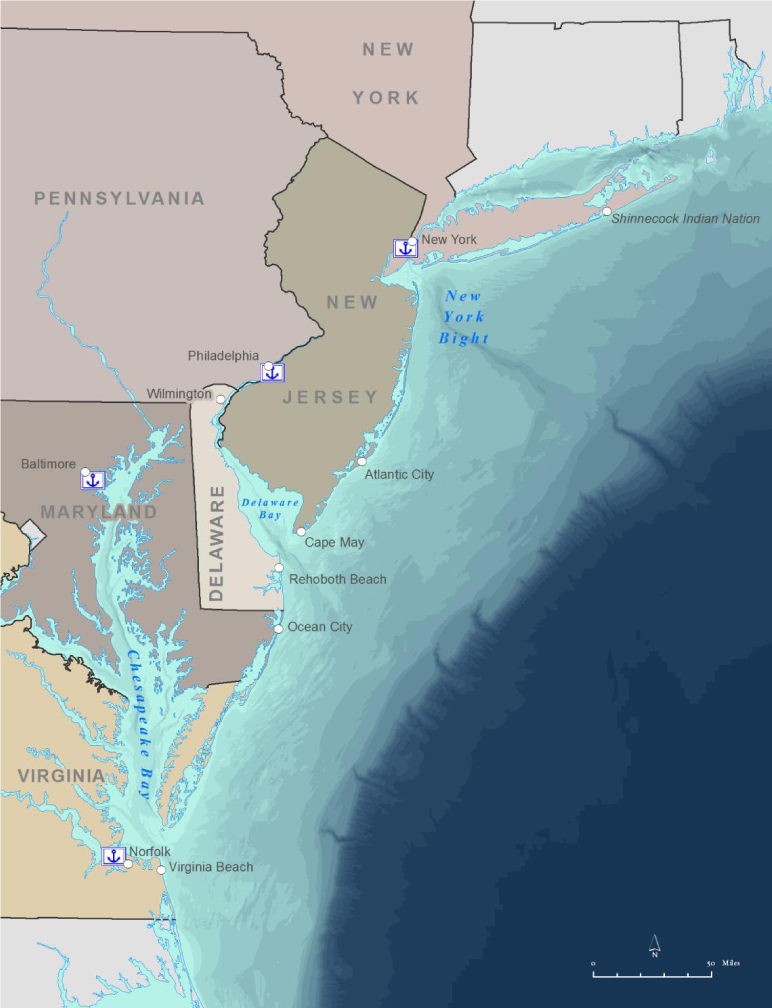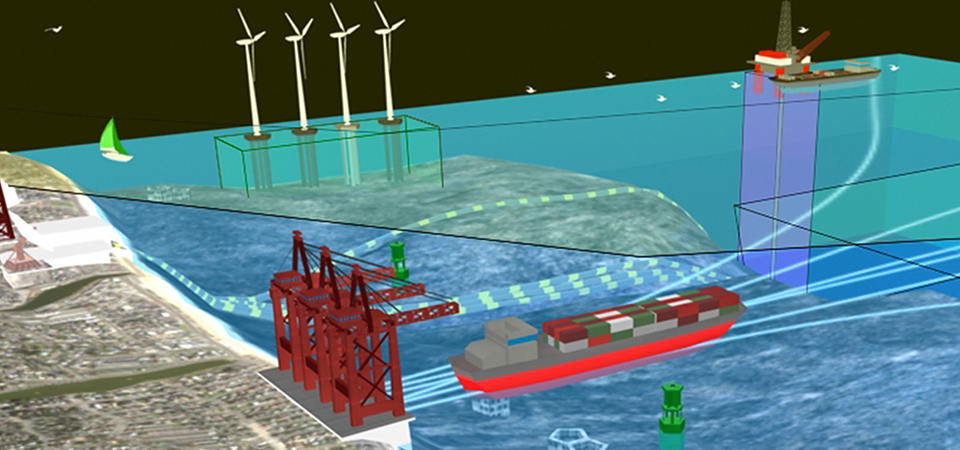INTRODUCTION
Purpose and Structure of the Regional Ocean Assessment
Overview of the Regional Ocean Assessment
- Characterizing the Mid-Atlantic Ocean Ecosystem and Resources provides context for regional ocean planning by giving an overview of Mid-Atlantic geography, oceanography, marine life, human components, and ecosystem changes.
- Toward Ocean Planning Objectives: Status, Trends, and Linkages focuses on aspects of the ecosystem that relate directly to goals and objectives of the Ocean Action Plan.
- Characterizing Mid-Atlantic Ocean Uses presents a brief overview of how people use the ocean in the region and of economic activity associated with the ocean.
- Toward Ocean Planning Objectives: Status, Trends, and Linkages describes major ocean uses related to the Ocean Action Plan and recent and anticipated changes in those uses.
The Need for Ocean Planning
What Lies Ahead for the Mid-Atlantic Ocean?
The following are examples of changes that are anticipated to occur in the next 20 years and that have implications for regional ocean planning.
Changes in the Ecosystem
- Rising sea levels
- Increasing incidents of extreme weather, including intense precipitation, extra-tropical storms, and hurricanes
- Shifts in the distribution of fish stocks as species move northward and/or offshore in response to oceanic changes
- Changing food web dynamics
- Increasing acidity of the ocean
- Changing ocean circulation patterns
Changes in Ocean Uses
- Changes in ship traffic patterns and increased ship size
- Major changes to harbor infrastructure, including deepening of channels and raising bridges to accommodate the larger ships
- Increased interest in offshore sand mining
- Development of offshore wind farms
- Potential exploration for oil and gas deposits in portions of the Mid-Atlantic
- Placement of telecommunications and energy transmission infrastructure
- More recreational use of the ocean
Ocean Planning in the Mid-Atlantic Region
The National Ocean Policy establishes a framework for people of the United States to conduct ocean planning toward a healthy marine ecosystem and sustainable use of the ocean. Ocean planning is a science- and information-based process that can help advance local and regional interests. To develop regional ocean plans, representatives from multiple levels of government work together, publicly and transparently, as a regional planning body. Their work is informed by the expertise and perspectives of stakeholders whose participation ensures that the planning is based on a full understanding of the range of interests and interactions in each region. Under the National Ocean Plan, the scope, scale, and content of ocean plans are defined by the people in the regions themselves—to address shared regional priorities in ways that reflect their unique interests, capacity to participate, and ways of doing business.
Although now disbanded, the Mid-Atlantic Regional Planning Body (RPB) led a collaborative process to implement ocean planning. It was comprised of representatives from eight federal agencies with ocean interests1, six Mid-Atlantic states (New York, New Jersey, Pennsylvania, Delaware, Maryland, Virginia), three federally recognized tribes (Shinnecock Indian Nation, Oneida Indian Nation, Pamunkey Indian Tribe), and the Mid-Atlantic Fisheries Management Council. The Mid-Atlantic RPB received support from the Mid-Atlantic Regional Council on the Ocean (MARCO), a partnership formed in 2009 by the governors of New York, New Jersey, Delaware, Maryland, and Virginia. The RPB’s work and this Regional Ocean Assessment were also informed by the Mid-Atlantic Ocean Data Portal, an interactive mapping site that is updated regularly with data on the region’s marine ecology and the ways people use and interact with the ocean.
The Mid-Atlantic RPB initiated the regional ocean planning process in 2013 and released a draft Ocean Action Plan for public comment in mid-2016. The RPB submitted the final Mid-Atlantic Regional Ocean Action Plan to the National Ocean Council and released the plan in November 2016. Non-government organizations, educational institutions, fishermen, industry representatives, and the public are all important stakeholders and are integral to the planning effort. The Mid-Atlantic RPB sought to incorporate traditional knowledge and values from tribes, fishermen, and many others who can provide historical, ecological, cultural and economic context and contribute to a shared understanding of ocean and coastal sites.
After the RPB was disbanded, the Mid-Atlantic Committee on the Ocean (MACO) was established to continue collaboration between states, federal agencies, the Mid-Atlantic Fishery Management Council (MAFMC), and federally recognized tribes.
Goals of Mid-Atlantic Regional Ocean Planning
The Mid-Atlantic RPB envisions an ocean where safe and responsible use and stewardship support healthy, resilient, and sustainable natural and economic ocean resources that provide for the well-being and prosperity of present and future generations. In keeping with that vision, the Mid-Atlantic RPB defined two goals for the Ocean Action Plan:
- Healthy Ocean Ecosystem: Promote ocean ecosystem health, functionality and integrity through conservation, protection, enhancement, and restoration.
- Sustainable Ocean Uses: Plan and provide for existing and emerging ocean uses in a sustainable manner that minimizes conflicts, improves effectiveness and regulatory predictability, and supports economic growth.
The two sections of the Regional Ocean Assessment — Ocean Ecosystem and Resources and Ocean Uses — inform efforts to achieve those interrelated goals.
1 The eight federal agencies represented on the Mid-Atlantic Regional Planning Body are the Department of Agriculture (represented by the Natural Resources Conservation Service), Department of Commerce (represented by the National Oceanic and Atmospheric Administration), Department of Defense and the Joint Chiefs of Staff (represented by the U.S. Navy), Department of Energy (represented by Energy Efficiency & Renewable Energy), Department of Homeland Security (represented by the U.S. Coast Guard), Department of the Interior (represented by the Bureau of Ocean Energy Management), Department of Transportation (represented by the Maritime Administration), and Environmental Protection Agency.



